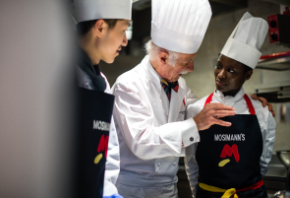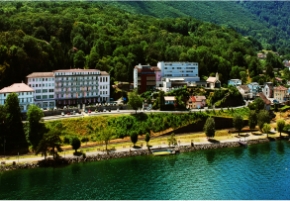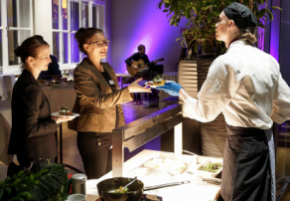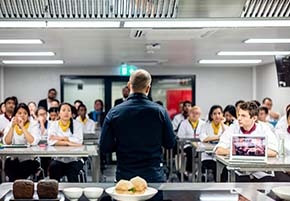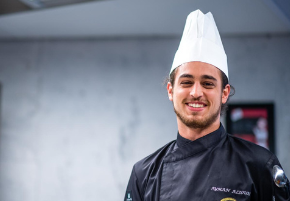- About
- Programs
- Campus Life
- Career Services
- Admissions
- News & Events
- Alumni
20+ Cooking Techniques Every Home Cook Should Know
Master 20+ cooking techniques and level up your meals—learn the methods pros use and start cooking smarter today!
Key Takeaways
- Cooking methods such as boiling and braising use different types of heat to affect texture and flavor, while techniques like folding and deglazing refine results.
- Combining dry and moist heat or using modern tools like sous vide can take dishes to a more advanced level.
- Getting a culinary degree at CAAS provides the structured training, expert guidance, and hands-on experience needed to turn passionate home cooks into skilled professionals.
Cooking techniques are used to prepare and transform raw ingredients into finished dishes. These techniques—such as roasting, boiling, sautéing, and steaming—determine how food develops in texture, flavor, and appearance.
Even a small change in method can turn the same ingredient into something crisp, tender, smoky, or delicate. For example, grilling vegetables brings out a blackened depth, while steaming keeps them bright and crisp.
Understanding different cooking techniques allows chefs to control the outcome of a dish, enhancing not just how it tastes but also how it feels and looks on the plate.
Different Types of Cooking Techniques
In the culinary world, cooking techniques are typically grouped into three main categories:
- Dry heat methods cook food without added liquid, using air or fat for heat transfer.
- Moist heat methods rely on water or steam to gently cook ingredients.
- Combination methods bring the two together, using both dry and moist heat to develop deeper flavor and tenderness.
Dry heat cooking techniques
Dry heat cooking uses air or fat to transfer heat to food, typically at higher temperatures. These methods remove surface moisture, creating browning and crisp textures that enhance both flavor and appearance. Dry heat techniques are especially effective for proteins, vegetables, and baked goods, adding depth without relying on water or steam.
Roasting
Roasting cooks food evenly using hot air. The consistent, high heat caramelizes natural sugars and deepens the flavor. This method dates back to prehistoric times when humans cooked meat over open flames on spits. Today's oven roasting is essentially a refined version of this ancient practice.
Roasting surrounds the food with dry heat, allowing the outside to brown while the inside stays tender. It's commonly used for meats like chicken, beef, and pork and also works well for hearty vegetables like potatoes, carrots, and squash.
Roasting pans or baking sheets are typically used, sometimes with racks, to allow air circulation. Seasoning and a light coating of oil help boost crispness and enhance taste.
Baking
Start Your Culinary Journey
Learn the art of cooking in a world-class environment
Baking involves cooking food through steady, dry heat in an enclosed space such as an oven—a method with a long history, as evidenced by ancient archeological finds.
Unlike roasting, baking is typically used for batters and doughs that rise and solidify, including bread, cakes, cookies, pies, and even casseroles and baked pasta, as well as different types of pastries. The even heat allows these foods to cook through gently, preventing the exterior from burning before the inside is done.
Proper temperature control is crucial in baking (arguably one of the most precise aspects of the culinary world). Even minor fluctuations in heat can dramatically change the outcome, affecting not just texture but also the rise, color, and moisture of your baked goods.
For instance, a cake baked at too low a temperature may sink in the middle, while one exposed to too much heat may burn on the outside before fully cooking inside. That's why most recipes stress the importance of preheating the oven: it ensures a consistent environment from the moment your batter or dough goes in.
Equally important is selecting the right bakeware: metal pans for browning, glass for even heating, or ceramic for slow, steady cooking. Each choice plays a role in how heat transfers to the food, and understanding these variables is what turns a good baker into a great one.
Grilling
Grilling cooks food quickly over an open flame or hot surface, either outdoors or using an indoor grill pan. The direct heat chars the exterior, locking in juices and creating a strong, smoky flavor. It's perfect for steaks, burgers, chicken, fish, and vegetables like peppers or corn.
In Argentina, grilling is a national tradition known as asado, a social ritual that can last all day. To them, grilling is a part of their cultural identity and regional pride.
Grilling typically involves placing food on a metal grate above the heat source, which can be charcoal, gas, or electric. Marinating beforehand enhances tenderness and taste, whereas grill marks give food a distinctive, appetizing look.
Because grilling uses intense, direct heat, it's best suited for foods that cook quickly (like thin cuts of meat, seafood, or tender vegetables). Timing is everything: overcooking happens fast, and one moment too long on the grill can turn juicy steaks or vibrant veggies into dry, charred disappointments.
That's why it's essential to stay attentive, turning food often to ensure even cooking and to prevent burning. Thinner items like shrimp or sliced zucchini can cook in just a few minutes per side, while thicker cuts like bone-in chicken require careful management of heat zones to avoid undercooking inside.
Sautéing
Sautéing involves cooking food quickly in a hot pan using a small amount of fat. The term comes from the French for "to jump," reflecting how food moves in the pan. This technique is the foundation of many classic sauces in French cuisine. Chefs often build a dish's entire flavor profile by first sautéing aromatics like onions, garlic, or shallots in fat.
Beyond that, sautéing is ideal for thin cuts of meat, seafood, and vegetables that cook quickly, such as mushrooms or bell peppers. The goal is to brown the surface without overcooking the inside.
A wide, flat skillet and high heat are key for even cooking, while stirring or flipping keeps food from burning.
Given that sautéing is a fast-paced technique, preparation is everything. All ingredients should be washed, chopped, measured, and within arm's reach before you even turn on the stove.
Read the recipe carefully; ingredients are often added in a specific order based on how long they take to cook. For instance, harder vegetables like carrots go in before delicate ones like spinach, and proteins may need to brown first before aromatics are added.
Since things move quickly over high heat, there's little time to improvise, and even a few seconds of distraction can lead to burning or uneven cooking.
Broiling
Broiling can be seen as upside-down grilling, applying intense heat from above using the oven's broiler setting. Food sits close to the heat source, usually on a broiler pan or rack, so the top gets crisp and browned. It's great for finishing dishes, melting cheese, or quickly cooking thin cuts of meat, fish, or vegetables.
Broiling works best when food is evenly cut and monitored closely, as it can burn quickly. Since it cooks only from one side, some foods may need to be flipped for even results. A light brush of oil and seasoning enhances browning and flavor.
Pan-frying
Pan-frying involves cooking food in a moderate amount of oil in a shallow pan, typically over medium to high heat. Unlike deep-frying, the food is only partially submerged, so it cooks from the bottom up and may need turning.
This cooking method is perfect for achieving a golden, crispy exterior while keeping the inside of your food moist. It works well for breaded items like chicken cutlets, pork chops, or vegetable fritters. In traditional Japanese cuisine, pan-frying is used in dishes like okonomiyaki—a savory pancake filled with cabbage, meat, or seafood. The contrast between the crispy outside and tender inside shows off pan-frying's textural control.
To help with even heat distribution, using cast iron or heavy-bottomed skillets is usually preferred, as these retain and distribute heat more consistently across the surface.
Just as critical is resisting the urge to overcrowd the pan. When too much food is added at once, the oil temperature drops rapidly, disrupting the frying process. Instead of crisping, the food begins to steam, leading to pale, limp, or greasy results.
For the best texture, cook in smaller batches, giving each piece enough room to sizzle freely. Between batches, give the oil a moment to return to the proper temperature, and skim out any leftover crumbs that might burn and affect flavor.
Deep-frying
Deep-frying submerges food completely in hot oil, cooking it rapidly and evenly. The intense heat creates a crisp, golden crust while sealing in moisture. It's popular for fries, doughnuts, fried chicken, tempura, and more. Temperature control is crucial—usually around 350–375°F—to avoid greasy or undercooked results.
This technique originated as early as 2500 B.C. when ancient Egyptians fried what appeared to be known as tiger nut cakes. Though often regarded as unhealthy because of the fat, deep-frying your food is also beneficial for killing off any bacteria and preserving nutrients.
Today, deep-frying is used around the world for dishes like fried chicken, French fries, tempura, samosas, doughnuts, and churros.
To deep-fry effectively, you will need a deep pot or fryer, along with a thermometer for controlling oil temperature. Once cooked, food should be drained on paper towels or a rack to remove excess oil. While rich and indulgent, deep-frying can deliver complex textures and bold flavor when done well.
Moist heat cooking techniques
Moist heat cooking uses water, steam, or other liquids to transfer heat and cook food gently. Unlike dry heat methods like baking or grilling, moist heat techniques such as boiling, steaming, or braising help retain moisture, soften tough cuts, and often preserve delicate flavors and nutrients.
Boiling
Boiling involves cooking food in water or broth at 100°C (212°F), creating rapid bubbles. It's best for foods that need full cooking and can withstand high heat, like pasta, potatoes, rice, and hard-boiled eggs. It's also used to blanch vegetables before freezing.
Boiling, however, can cause some nutrient loss, especially vitamin C. Still, it remains one of the oldest cooking methods globally. In many cultures, boiling was one of the first cooking techniques for communal meals due to its simplicity and ability to cook large quantities.
While boiling is simple, a few tips can make it more effective. For example, when boiling eggs, start in cold water and heat slowly to avoid cracking. Once boiling, lower the heat to a gentle simmer. Cook for 9–12 minutes for firm yolks or 6–8 for soft ones. Afterward, cool the eggs in ice water to stop cooking and make peeling easier.
Boiling pasta? Salt the water generously. For vegetables, avoid overboiling to preserve color and nutrients, and try using a lid to bring water to a boil faster.
Simmering
Simmering uses lower heat than boiling, with liquid temperatures around 85–96°C (185–205°F). The gentle bubbles make it perfect for cooking dishes that need time to develop rich flavors, such as soups, stews, curries, and sauces. It's especially helpful for tenderizing meats and blending spices.
Unlike boiling, simmering prevents food from breaking apart. This technique is often the secret behind many classic dishes, like French coq au vin or Italian marinara, where depth of flavor is key.
To get the most out of simmering, pay attention to timing. Add dried herbs early so they have time to release their full aroma, but save delicate fresh herbs (like parsley or basil) for the end when the dish is nearly done.
Use a lid to maintain moisture, especially during long simmers, and keep an eye on the surface: small, slow bubbles mean you're at the right temperature. If the liquid boils too hard, lower the heat to avoid toughening meat or thinning out flavors.
Steaming
Steaming cooks food by surrounding it with hot vapor from boiling water without the food making direct contact with the liquid. It's ideal for vegetables, seafood, dumplings, and even desserts like sponge puddings.
Steaming preserves flavor, texture, and more nutrients than boiling. Plus, it doesn't require oil, making it a healthier option. Bamboo steamers have been used in Chinese cooking for over 5,000 years, showing just how long people have relied on this gentle and efficient cooking technique.
For best results, wait until you see a strong, steady stream of steam before adding food to the steamer. Placing vegetables over slowly warming water can cause dull color and soggy texture.
Cut items to uniform sizes for even cooking, and don't overcrowd the steamer (steam needs space to circulate). For extra flavor, try adding herbs, citrus slices, or aromatics like ginger to the water below. Always keep the lid closed during cooking to trap heat and maintain a consistent steam environment.
Poaching
Poaching gently cooks food in liquid heated to about 71–82°C (160–180°F), making it suitable for delicate ingredients like eggs, chicken breasts, fish, and fruits. It keeps food tender and moist without overcooking.
Similar to steaming, poaching avoids aggressive bubbling that can break food apart, making it perfect for light, clean dishes. The classic French dish, poached pear, dates back centuries and showcases the elegance of this subtle method used during medieval times, typically for preserving fruit.
When poaching eggs, for example, freshness matters. Older eggs tend to spread or form wispy threads in the water, while fresh eggs hold their shape much better.
For best results, crack each egg into a small bowl first, then gently slide it into barely simmering water. Adding a splash of vinegar can help the whites coagulate faster, and avoiding a rolling boil prevents the egg from breaking apart. Aim for about 3–4 minutes for a soft, runny yolk with a tender white.
Combination and advanced techniques
Some cooking methods combine dry and moist heat, such as braising and stewing, which sear food first, then cook it slowly in liquid. The initial searing helps seal in the juices by creating a caramelized crust on the surface, which locks moisture inside the meat.
Without this step, juices can leak into the cooking liquid, leaving the meat dry and tough, even though it's surrounded by liquid. It's a result that can seem counterintuitive, but the contrast between the dry-heat sear and the gentle, moist simmer is what makes these methods so effective at producing tender, flavorful results.
Modern or advanced techniques, such as sous vide and pressure cooking, offer new ways to achieve precision and consistency. Sous vide uses carefully controlled water temperatures, while pressure cooking accelerates the cooking process using steam and high pressure. Both offer control, efficiency, and consistent results.
Braising
Braising is a combination cooking method that starts by searing food, typically tougher cuts of meat or hearty vegetables, at high heat, then slowly cooking it in a covered pot with a small amount of liquid. This age-old technique, dating back over 300,000 years, breaks down connective tissues, resulting in tender, flavorful dishes like pot roast or osso buco.
Pro tip for osso buco: Tie the veal shanks with kitchen twine before cooking to keep the meat securely attached to the bone during braising. This prevents it from falling apart into the stew as it becomes tender. Once fully cooked, carefully cut and remove the string before serving. The result: meat that's perfectly "fall-off-the-bone" tender while still beautifully presented on the bone.
Stewing
Stewing involves simmering small, uniform pieces of meat or vegetables fully submerged in liquid over low heat. It's ideal for tougher cuts of meat, beans, or root vegetables, transforming them into tender, flavorful meals.
Unlike braising, stewing uses more liquid, resulting in a dish where the ingredients and broth are served together. Historically, stewing is one of the oldest cooking methods, with evidence suggesting that early humans used natural containers like turtle shells to boil food.
However, turtle shells were eventually replaced by cast iron, which remains a top choice for stewing thanks to its excellent heat retention and even distribution. Enameled cast iron is especially popular today: it's easy to clean, doesn't react with acidic ingredients, and eliminates the need to worry about rust.
Stir-frying
Stir-frying is a Chinese cooking technique in which small, uniform pieces of food are quickly cooked over high heat in a wok with a minimal amount of oil. It dates back over 2,000 years to the Han Dynasty in China; then, the term "stir-fry" was introduced to English speakers in 1945 by Buwei Yang Chao in her book How to Cook and Eat in Chinese.
This method is perfect for vegetables, meats, and noodles, preserving their texture and flavor. Just like with sautéing, timing is everything. Add ingredients in stages based on their cooking times; start with proteins or firm vegetables like carrots, and add quicker-cooking items like snow peas or bean sprouts at the end. This ensures the meat is fully cooked while delicate vegetables stay crisp and bright, not limp or overdone. Have everything prepped before you start.
Sous vide
Sous vide, which translates to "under vacuum" from French, is a cooking technique where food is sealed in an airtight bag and gently cooked in a water bath maintained at a consistent, low temperature. This technique ensures even cooking and retains moisture, making it ideal for meats, seafood, and vegetables.
Sous vide cooking helps steaks retain more moisture compared to traditional methods, where they can lose as much as 40% of their juices.
After sous vide cooking, always finish the meat with a quick sear in a hot pan or on a grill. This adds the browned, caramelized exterior that sous vide alone can't provide, giving you the best of both worlds: perfect internal doneness with a flavorful crust.
Blanching
Blanching involves briefly boiling food, usually vegetables or fruits, and then rapidly cooling them in ice water to halt the cooking process. This technique preserves color, texture, and nutritional value, making it essential before freezing or canning.
Blanching (along with boiling and stir-frying) can help remove pesticide residues and decrease the microbial load on produce. It's also an essential step in preparing some vegetables for further cooking methods like stir-frying or roasting.
Smoking
Smoking is a traditional method of both cooking and flavoring food by exposing it to smoke from burning wood, often used for meats, fish, and cheeses. This technique not only imparts a distinctive smoky flavor but also acts as a preservative, destroying microorganisms and enzymes through the use of heat. Different types of wood, like hickory, mesquite, cherry, or applewood, can impart unique flavors and aromas to smoked food.
When smoking at home, you can use a charcoal or gas grill with a smoker box or foil packet filled with soaked wood chips. Keep the heat low and cook indirectly by placing the food on the cooler side of the grill.
For indoor smoking, stovetop smokers or smoke guns can be used to infuse flavor without outdoor equipment. No matter the setup, be sure to monitor the temperature closely and keep the lid closed to trap the smoke and build that deep, rich flavor.
Useful techniques to know
There are also helpful cooking techniques that, while used less frequently, can enhance texture and flavor. These include caramelizing, deglazing, reducing, and folding.
Caramelizing
Caramelizing is the process of slowly cooking sugar or sugar-containing foods until they turn golden brown and develop a rich, sweet flavor. This reaction occurs as sugars break down under heat, typically between 160–177°C (320–350°F). It's commonly used in onions, carrots, and meats to enhance flavor depth and complexity.
Deglazing
Deglazing involves adding a liquid—such as wine, broth, or vinegar—to a hot pan to loosen and dissolve the flavorful bits of food (called fond) that have stuck to the bottom after sautéing or roasting. The fond leftover in a pan is considered liquid gold in culinary circles because it holds the most concentrated flavor. These bits are rich in taste and form the base of many sauces.
Deglazing is often used in French cooking to create pan sauces for meats or vegetables. It's a quick way to capture flavor and add richness to your dish without extra fat or salt.
Make sure the pan is still hot when adding your liquid, and scrape with a wooden spoon or spatula to lift up all the browned bits. If using alcohol like wine or brandy, let it simmer for a minute to cook off the harshness and reduce it slightly. This intensifies the flavor and helps the sauce thicken.
Reducing
Reducing is the process of simmering or boiling a liquid, such as stock, wine, or sauce, to evaporate water and concentrate flavor and thickness. This technique is commonly used to intensify sauces, soups, or glazes. The longer a liquid reduces, the stronger and richer the taste becomes.
Reducing is especially useful when you want to deepen flavor without adding more ingredients. It also helps improve the texture and visual appeal of a dish by creating a thicker, glossier finish.
Though boiling may feel like it speeds up the process, you risk scorching the thickening liquid at the bottom of the pan. For best results, keep it at a low simmer for an extended period, stirring occasionally to prevent sticking and ensure an even, gradual reduction.
Folding
Folding is a gentle mixing technique used to combine light, airy ingredients, such as whipped cream or beaten egg whites, with heavier mixtures like cake batter. The term "fold" in recipes often confuses beginners. It's not stirring or mixing but a slow motion meant to trap air and build fluffiness.
The motion involves carefully lifting and turning the mixture to maintain volume and avoid deflating the air bubbles. This technique is essential in baking, especially for mousse, soufflés, and sponge cakes.
Tips for Practicing These Methods and Techniques at Home
Mastering cooking techniques takes time, but with some patience and the right habits, anyone can grow more confident in the kitchen. Whether you're just starting out or looking to sharpen your skills, practicing at home is the perfect place to begin. Here are some helpful tips to make your learning process smoother and more enjoyable:
- Focus on one method or technique at a time so you can fully understand how it works without feeling overwhelmed.
- Practice mise en place by prepping and organizing all your ingredients before you start cooking to stay efficient and avoid stress.
- Invest in basic tools like a good knife, a sturdy pan, and a food thermometer.
- Taste your food as you go. It helps you understand how flavors develop and lets you adjust seasoning as needed.
- Watch videos or tutorials to see techniques in action and learn directly from experienced cooks and chefs.
- Cook regularly so the techniques become second nature over time.
- Be patient with yourself, and have fun experimenting with different ingredients, flavors, and dishes.
Master These Cooking Techniques
From boiling and braising to caramelizing and sous vide, each cooking technique has its place in creating flavorful, balanced dishes. By learning when and how to use them, you can turn simple ingredients into something truly impressive.
If you're serious about mastering these skills, getting a Swiss Diploma or a Bachelor's Degree in Culinary Arts at Culinary Arts Academy Switzerland (CAAS) is a smart move. With expert guidance, hands-on training, and a passion-driven environment, our programs are designed to help you build both technical expertise and creative confidence, setting you up for success in professional kitchens around the world.
Frequently Asked Questions (FAQs)
What is the difference between a cooking method and a technique?
A cooking method is the overall process used to cook food, like baking or steaming, while a technique is a specific skill within that method, such as folding or searing.
How long does it take to master a cooking technique?
It depends on the technique and how often you practice. With consistent effort, most home cooks can become comfortable with basic techniques in a few weeks.
What cooking techniques are best for beginners?
Boiling, sautéing, roasting, and folding are great starting points for learning control and flavor basics.
Interested in becoming a world-class chef? Learn more about Culinary Arts Academy Switzerland. Download our brochure.





